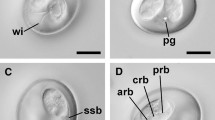Abstract
Rhinoestrus purpureus and Rhinoestrus usbekistanicus (Diptera: Oestridae) cause specific nasal myiases of family equidae and are of importance in the horse medicine since it causes severe respiratory diseases. During an epidemiological survey in donkeys from Beni Suef government, Egypt; some morphological and taxonomical doubts arose concerning the identification of Rhinoestrus spp. 1st, 2nd and 3rd stage larvae based on the features of the posterior spiracles and the distribution of dorsal spines on the third segment. Four different morphotypes were retrieved: R. usbekistanicus, R. purpureus and two morphotypes with shared features. The genes encoding for the mitochondrial cytochrome oxidase I (COI) and for the ribosomal subunits 16S and 28S of the four morphotypes of Rhinoestrus were investigated to determine whether they belonged to a single taxon or they displayed genetic differences indicative of more than one species. The genes showed a very low level of sequence variation (COI 0–0.43%, 16S 0–1.45%, 28S 0–0.23%) falling within the intraspecific ranges. Finally, the peritreme features and the spinulation of the third segment of the two morphotypes examined could not be used to differentiate the Rhinoestrus spp.










Similar content being viewed by others
References
Attia, M.M., Salaeh, N.M. (2020) Ultrastructure of adult Gasterophilus intestinalis (Diptera: Gasterophilidae) and its puparium. Int J Trop Insect Sci 40, 327–335 (2020). https://doi.org/10.1007/s42690-019-00084-9
Attia MM, Khalifa MM, Mahdy OA (2018) The prevalence of Gasterophilus intestinalis (Diptera: Oestridae) in donkeys (Equus asinus) in Egypt with special reference to larvicidal effects of neem seed oil extract (Azadirachta indica) on third stage larvae. Open Vet J 8(4):423–431
Dong J, Bao H, Mang L (2018) Ultramorphological and molecular characteristics of the larval stages of the horse nasal-myiasis fly, Rhinoestrus sp. (Diptera: Oestridae) from Mongolian horse in China. Microsc Res Tech 81:198–206. https://doi.org/10.1002/jemt.22965
Guitton C, Dorchies P, Morand S (1996) Scanning electron microscopy of larval instars and imago of Rhinoestrus usbekistanicus Gan, 1947 (Oestridae). Parasite 3(2):155–159
Guitton C, Dorchies P, Morand S (1997) Morphological comparison of second stage larvae of Oestrus ovis (Linnaeus, 1758), Cephalopina titilattor (Clark, 1816) and Rhinoestrus usbekistanicus Gan, 1947 (Oestridae) using scanning electron microscopy. Parasite 4(3):277–282
Hilali M, Mahdy OA, Attia MM (2015) Monthly variations of Rhinoestrus spp. (Diptera: Oestridae) larvae infesting donkeys in Egypt: morphological and molecular identification of third stage larvae. J Adv Res 6:1015–1021
James MT (1947) The flies that cause myiasis in man. USDA Miscellaneous Publication No. 631. US Government Printing Office, Washington, DC, PP. 117–118
Lunt, D. H., Zhang, D. X., Szymura, J. M. & Hewitt, G. M. (1996): The insect cytochrome oxidase I gene: evolutionary patterns and conserved primers for phylogenetic studies. Insect Molecular Biology. 5:153–165
Mula, p., Francisco, I., Arias, M., Cortinas, F. J., Suarez, J.L., Sanchez, J.A., Romasanta, A., Paz-Silva, A., Morrondo, P., Sanchez- Andrade, R. and Scala, A. (2009): Seasonal evolution of Rhinoestrus spp. larvae in horses under Mediterranean climate. Jornadas de Estudio 13:158–160
Mula P, Pilo C, Solinas C, Pipia AP, Varcasia A, Francisco I, et al. (2013) Epidemiology, chronobiology and taxonomic updates of Rhinoestrus spp. infestation in horses of Sardinia Isle, Western Mediterranean (Italy). Vet Parasitol 192:240–6
Otranto D, Milillo P, Traversa D, Colwel DD (2005) Morphological variability and genetic identity in Rhinoestrus spp. causing horse nasal myiasis. Med Vet Entomol 19:96–100
Otranto D, Stevens JR, Brianti E, Dorchies P (2006) Human and livestock migrations: a history of botfly biodiversity in the Mediterranean region. Trends Parasitol 22:209–213
Otranto, D. & Colwell, D. D. (2008): Biodiversity and extinction versus control of oestrid causing myiasis in the Mediterranean area. Parasite 15:257–260
Peyeresblanques J (1964) Ocular myiasis. Ann Oculularis (Paris) 197:271–295
Yana L, Ming Z, Liping T, Make E, Xinping M, Hongjun C, Kai L, Defu H, Dong Z (2019) First reports of nasal and traumatic myiasis infection in endangered Przewalski's horses (Equus ferus przewalskii). IJP: Parasites Wildl 9:21–24
Zhang, D.X., Hewitt, G.M. (1996): Nuclear integrations: challenges for mitochondrial DNA markers. Trends of Ecological and Evolution. 11:247–251
Zayed AA, Hilali M, El Metenawy TM (1993) Studies on Rhinoestrus purpureus (Diptera: Oestridae) larvae infesting donkeys (Equus asinus) in Egypt. Incidence and seasonal variations. J Equine Vet Sci 13:46–49
Zumpt F (1965) Myiasis in man and animals in the Old World. Butterworth, London, pp 159–164
Funding
No funding received for this work.
Author information
Authors and Affiliations
Contributions
Olfat A. Mahdy and Marwa M. attia Conception, design of the study. Marwa M. attia collection and rearing of the larvae; Marwa M. attia photographed the samples; Olfat A. Mahdy Analysis and interpretation of the data. Olfat A. Mahdy and Marwa M. attia Drafting and revising the manuscript for important intellectual content. All authors read and approved the final manuscript.
Corresponding author
Ethics declarations
Conflict of interest
All Authors declare that there is no conflict of interest.
Additional information
Publisher’s note
Springer Nature remains neutral with regard to jurisdictional claims in published maps and institutional affiliations.
Rights and permissions
About this article
Cite this article
Mahdy, O.A., Attia, M.M. Comparative micro-morphological and phylogenetic analysis between Rhinoestrus purpureus and Rhinoestrus usbekistanicus (Diptera: Oestridae) larvae and its adults. Int J Trop Insect Sci 41, 241–250 (2021). https://doi.org/10.1007/s42690-020-00199-4
Received:
Accepted:
Published:
Issue Date:
DOI: https://doi.org/10.1007/s42690-020-00199-4




